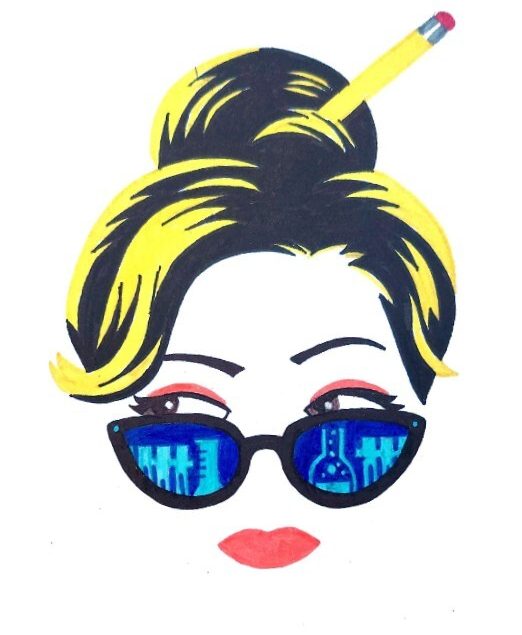In a dark television studio, women crowd the seating area, murmuring excitedly with one another as assistants frantically arrange ingredients around the pastel kitchen set. The director counts down the seconds until the show broadcasts live while the women eagerly await the host’s appearance. Finally, the red light above the stands blinks on, signaling the beginning of the recording, and the camera pans to reveal Elizabeth Zott stabbing a pencil into her blond updo and spinning around to address her supporters.
Apple TV+’s new adaptation of New York Times bestseller “Lessons in Chemistry” by Bonnie Garmus follows the life of genius female chemist Elizabeth Zott, played by Brie Larson, in the 1950s. Battling blatant sexism cemented in this era’s society, she attempts to expand her research and build credibility as a scientist. Blending witty humor with unique narration, “Lessons in Chemistry” highlights the harsh realities women faced in the scientific community.
The show commences with a glamorous scene of Elizabeth arriving at a television studio to record an episode of her cooking show, “Supper at Six.” A crowd full of women cheer loudly while waving their notebooks and pencils in the air. Elizabeth’s green pants and demure outfit contrast sharply with the floral dresses, pearl necklaces, and lacy gloves common in the crowd.
Immediately, “Lessons in Chemistry” leans into its theme of feminism and female power. Numerous male assistants approach Elizabeth as she strides confidently down the hallway, deferring to her opinion on every decision from tomatoes to baking dishes, and scrambling to prepare the set before her entrance.
Revealing her strong-willed nature, Elizabeth strays from her prepared cue cards, frustrating her superiors, but empowering housewives around the country with her genuine message and ability to make each woman feel capable and appreciated.
Following this initial clip of Elizabeth as a famous television host, the story jumps back seven years, when it becomes evident that Elizabeth’s life was not always filled with adoring fans and illustrious opportunities.
Instead, Elizabeth, a brilliant chemist, works as a lab technician at the Hastings Research Institute, where her boss, a chauvinistic and self-aggrandizing man, prevents her from conducting research, instead delegating her to brewing coffee for her coworkers.
The only person who can parallel her in intelligence is Calvin Evans, portrayed by Lewis Pullman, a world-renowned yet socially isolated chemist.
After an unpleasant first impression, the two develop an unlikely partnership based on mutual respect and admiration that blossoms into a love story that defies the accepted gender roles of the time period, emphasizing Elizabeth’s commitment to independence.
Meanwhile, the adaptation transforms Elizabeth’s nosy neighbor character, Harriet Sloane, played by Aja Naomi King, into a young Black female lawyer, building on its messages surrounding societal prejudices and inequalities.
Harriet’s storyline focuses on her passionate fight against the California Highway Commission’s plans to bulldoze through her predominantly Black neighborhood. Inspired by real historical events in which cities employed infrastructure projects to dismantle African American communities and enforce segregation, Harriet’s struggle represents challenges Black communities faced in the 1950s.
The parallels between Elizabeth, a white woman battling sexism and discrimination in the workplace, and Harriet, a lawyer struggling to overcome all of these obstacles, with an added layer of race, allow the blossoming of a heartwarming friendship. Encouraging each other to pursue their passions and supporting each other during tough times, Harriet and Elizabeth use their platforms to speak out against injustice, sparking change one small act at a time.
Although the show is set in the 1950s, even today, the STEM field is largely dominated by men. While the proportion of women in these jobs is growing, they still only make up 28 percent of this workforce.
In an especially resonating scene from the show, Elizabeth shares her groundbreaking exploration into abiogenesis, the original evolution of organic beings from inorganic molecules, hindered by the repeated snubs of the male department heads. Calvin is astounded by her ideas and asks why she is not leading her own research lab. Elizabeth matter-of-factly cites “sex discrimination,” prompting Calvin’s confusion over gender-based discrimination in intellectual pursuits. When he protests, Elizabeth challenges him, asking how many female scientists he can name. With Calvin only able to think of Marie Curie, Elizabeth exposes the systematic underappreciation and oppression faced by female scientists.
For the women of the 21st century, this corresponds to stereotypes portraying STEM jobs as “masculine,” unfair wage gaps and ingrained prejudices that women are intellectually inferior to men.
With women only representing 19 percent of computer science majors, in a 2016 study by the National Science Foundation, it is clear that the image of the lone female chemist in a room full of men is not confined to the screen.
Eventually, these prevailing societal gender norms lead Elizabeth to lose her job when she becomes pregnant, forcing her to become a television show host in order to make ends meet financially.
While the show carries through major concepts from the novel, it also introduces new levels of complexity, widening the scope from one person’s challenges, to the problems an entire community faces. As Elizabeth and Harriet struggle to find a place for themselves in an oppressive society, they inspire others to rebel against the status quo and pursue their passions.




![LALC Vice President of External Affairs Raeanne Li (11) explains the International Phonetic Alphabet to attendees. "We decided to have more fun topics this year instead of just talking about the same things every year so our older members can also [enjoy],” Raeanne said.](https://harkeraquila.com/wp-content/uploads/2025/10/DSC_4627-1200x795.jpg)


















![“[Building nerf blasters] became this outlet of creativity for me that hasn't been matched by anything else. The process [of] making a build complete to your desire is such a painstakingly difficult process, but I've had to learn from [the skills needed from] soldering to proper painting. There's so many different options for everything, if you think about it, it exists. The best part is [that] if it doesn't exist, you can build it yourself," Ishaan Parate said.](https://harkeraquila.com/wp-content/uploads/2022/08/DSC_8149-900x604.jpg)




![“When I came into high school, I was ready to be a follower. But DECA was a game changer for me. It helped me overcome my fear of public speaking, and it's played such a major role in who I've become today. To be able to successfully lead a chapter of 150 students, an officer team and be one of the upperclassmen I once really admired is something I'm [really] proud of,” Anvitha Tummala ('21) said.](https://harkeraquila.com/wp-content/uploads/2021/07/Screen-Shot-2021-07-25-at-9.50.05-AM-900x594.png)







![“I think getting up in the morning and having a sense of purpose [is exciting]. I think without a certain amount of drive, life is kind of obsolete and mundane, and I think having that every single day is what makes each day unique and kind of makes life exciting,” Neymika Jain (12) said.](https://harkeraquila.com/wp-content/uploads/2017/06/Screen-Shot-2017-06-03-at-4.54.16-PM.png)








![“My slogan is ‘slow feet, don’t eat, and I’m hungry.’ You need to run fast to get where you are–you aren't going to get those championships if you aren't fast,” Angel Cervantes (12) said. “I want to do well in school on my tests and in track and win championships for my team. I live by that, [and] I can do that anywhere: in the classroom or on the field.”](https://harkeraquila.com/wp-content/uploads/2018/06/DSC5146-900x601.jpg)
![“[Volleyball has] taught me how to fall correctly, and another thing it taught is that you don’t have to be the best at something to be good at it. If you just hit the ball in a smart way, then it still scores points and you’re good at it. You could be a background player and still make a much bigger impact on the team than you would think,” Anya Gert (’20) said.](https://harkeraquila.com/wp-content/uploads/2020/06/AnnaGert_JinTuan_HoHPhotoEdited-600x900.jpeg)

![“I'm not nearly there yet, but [my confidence has] definitely been getting better since I was pretty shy and timid coming into Harker my freshman year. I know that there's a lot of people that are really confident in what they do, and I really admire them. Everyone's so driven and that has really pushed me to kind of try to find my own place in high school and be more confident,” Alyssa Huang (’20) said.](https://harkeraquila.com/wp-content/uploads/2020/06/AlyssaHuang_EmilyChen_HoHPhoto-900x749.jpeg)












